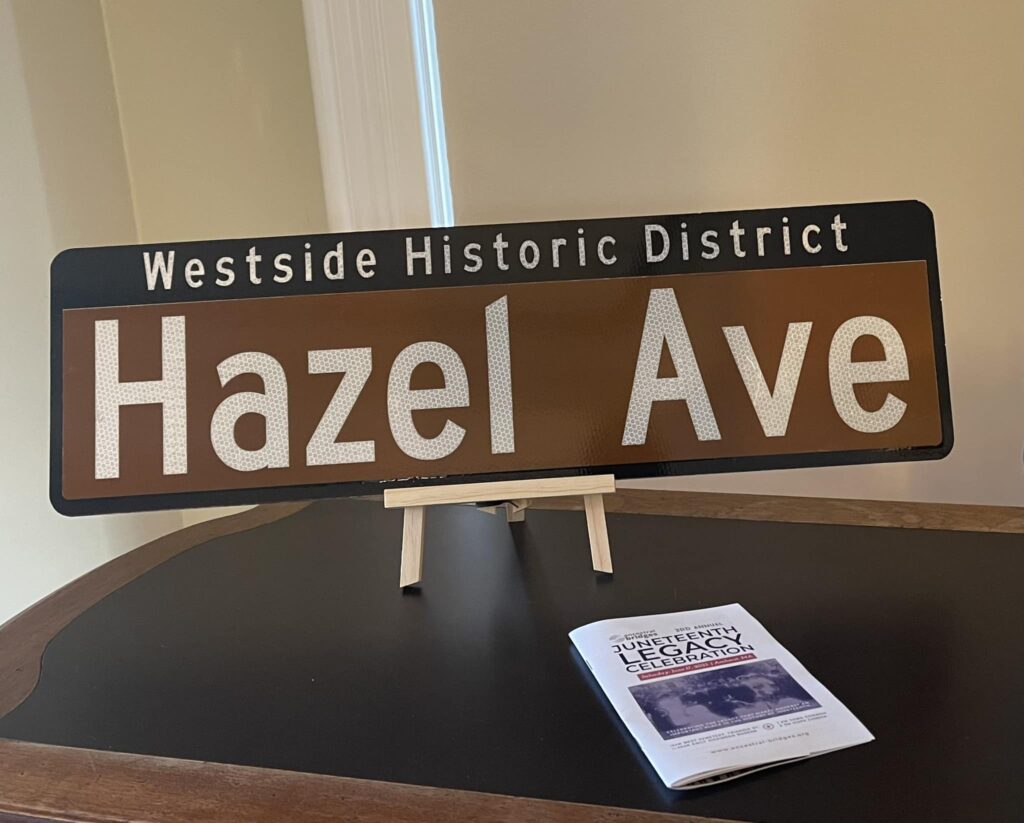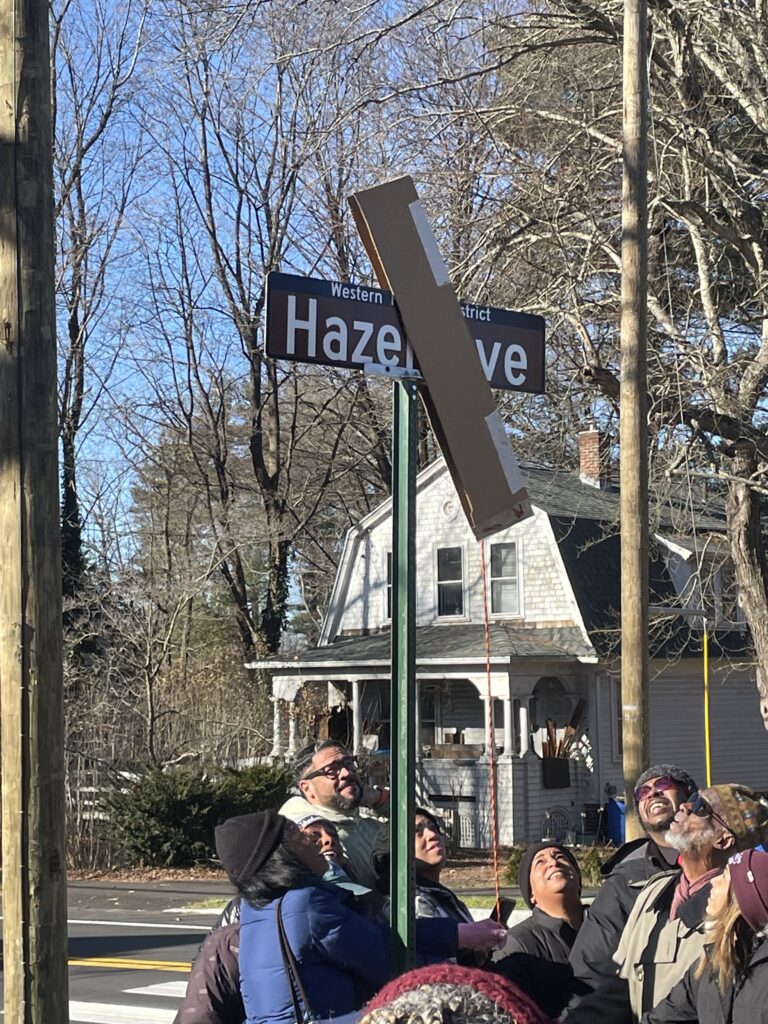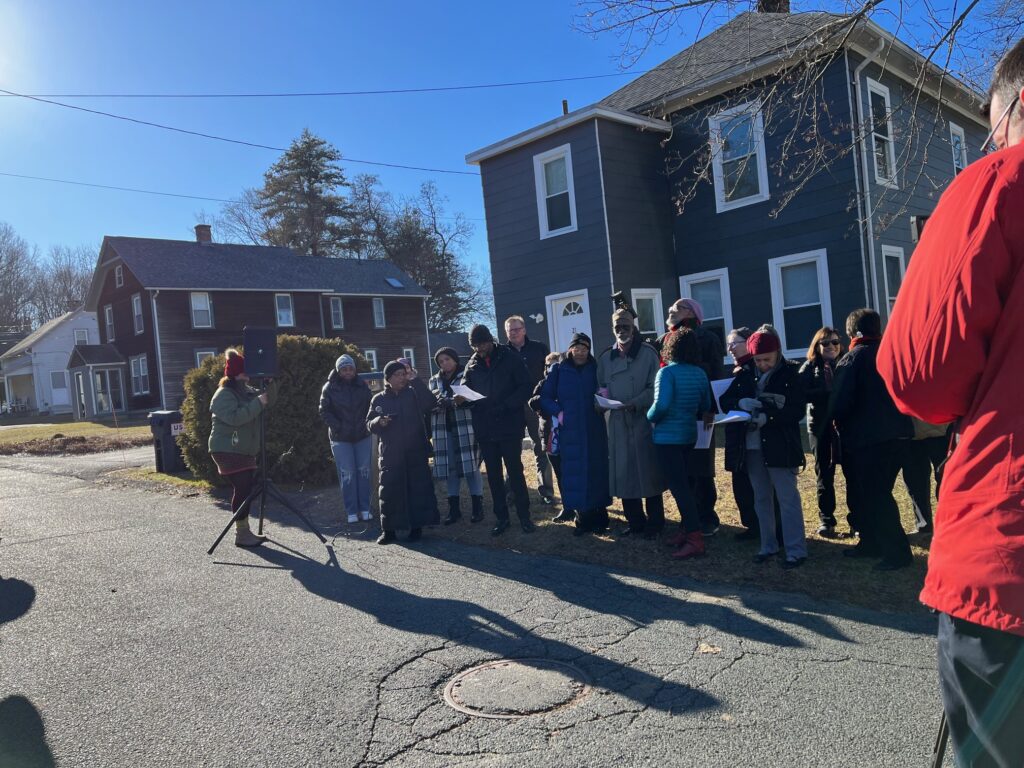
The Town of Amherst, in partnership with the Ancestral Bridges Foundation, celebrated Amherst’s Westside National Historic District on December 21, by installing a new street sign at the corner of Hazel Avenue and Northampton Road in Amherst and reading a proclamation passed at the December 18 Town Council meeting. State Representative Mindy Domb, town councilors, town staff, and about 50 members of the Amherst community attended the dedication ceremony on the chilly morning.
The brown Hazel Avenue street sign, marking one of the boundaries of the district, was first revealed by Councilor Anika Lopes at the 2023 Juneteenth Legacy Celebration on what would have been her grandfather Dudley Bridges’ 100th birthday. The sign was created by members of Amherst’s Department of Public Works. The Westside neighborhood, which includes Hazel Avenue, Baker Street, and parts of Snell Street and Northampton Road, stands as a testament to resilience, community, and a deep commitment to inclusivity. Other neighborhoods historically lived in by Amherst’s African American population include Railroad, Beston, and Paige Streets.

The Westside National Historic District project is a generational endeavor started by Lopes’ grandfather. The 40-acre site, home to Amherst’s African American residents for centuries, was initiated by Bridges in 1996, officially proposed as a National Historic District in 1998, and included in the National Register of Historic Places in 2000.
Wikipedia notes that “Most of the properties in the district are houses, many of which were built in a variety of Victorian styles, with houses built later also showing Colonial Revival styling. The oldest houses, on Baker Street, date from 1869 into the 1870s, while those along Route 9 were for the most part built later, and exhibit a wider variety of styles, including some Bungalow/Craftsman houses.”
“This neighborhood is one of the few places in Amherst where Blacks and Indigenous people could live and own homes during a period of time marked by slavery and systemic racist practices, including redlining, exclusionary zoning, inequitable GI bills, and housing segregation,” explained Lopes. “It’s a living history that embodies the strength, resilience, and determination of Black and Indigenous people who established a vibrant and enduring community in downtown Amherst despite horrific challenges.”
“I appreciate the efforts of the Town of Amherst to recognize and celebrate the historical part of town where my Black and Indigenous ancestors were relegated to live,” Lopes added. “I am proud to raise the significance and presence of my ancestors and the community who lived and died here. This official neighborhood dedication is significant, following my grandfather’s and mother’s daylighting and interpretation of Amherst’s Civil War tablets, now in the Bangs Community Center, and Ancestral Bridges’ collaboration with Amherst College, un-erasing our local Black and Indigenous past.”
Other notable ancestors who lived in the Westside District include internationally renowned jazz musician Gil Roberts, who was born in the house his father Perry Roberts built on Hazel Avenue in 1896. Perry Roberts was born enslaved, as was his father Perry and Frederick Douglass on Wye House plantation in Maryland.
At the dedication ceremony, which took place in front of Perry Roberts’ house, town officials and members of the African American community took turns reading paragraphs of the town proclamation. The proclamation concludes:
NOW, THEREFORE, BE IT PROCLAIMED that the Town Council of Amherst, MA, honors and recognizes the Westside Historic District for its profound historical importance as a haven for Black and Afro-Indigenous residents, defying the constraints of housing segregation and redlining, and contributing significantly to the cultural diversity and strength of our community. BE IT FURTHER PROCLAIMED that the residents of Amherst are encouraged to explore and appreciate the rich history of the Westside Historic District, and to continue fostering a community that celebrates diversity and inclusion.

Debora Bridges, who serves as the curator and guide for the Civil War Tablets exhibit, reflected on the community, saying, “Hazel Avenue was all family, always watching each other’s children as they played. The family musicians played in the summer nights and loved just being together.”
The Westside District, where Black residents were pushed due to exclusionary zoning, became more than a neighborhood, said Bridges. It evolved into a community built on love and care for each other. Despite facing challenges, this community thrived with laughter, joy, music, and a profound commitment to the broader community, establishing deep ties to institutions such as Amherst College, Hope Church, and the Goodwin Memorial A.M.E. Zion Church.
Sarah Barr, Advisor to the Amherst College Provost on Campus Initiatives said, “The unveiling of the historical sign marks a meaningful step towards acknowledging and uplifting the stories of those who have significantly contributed to the vibrancy of our community. This moment also presents a wonderful opportunity for community members to explore the Ancestral Bridges exhibit and photo display at Frost Library, offering valuable historical information for those eager to delve into the rich history of the Westside District and the Black and Afro-Indigenous residents of Amherst.”

It is great to have a moment of joy and celebration in town and in advance of a good cause. This dedication ceremony represents decades of effort, research and unstinting faith in revealing aspects of our hidden architectural and social history. We must do what we can to support telling and preserving all the stories that relate to where this town is located. Thank you to Anika Lopes, and Ancestral Bridges Foundation and to her mum, Deborah Bridges, who has been a great curator of the Civil War Tablets exhibit at the Bangs. This would have been my Features column for January, Maura but here it is, already available to people. My one suggestion might be to see if we can add a sign to the actual bike trail which is one of the places best situated for a good view of the district.
The nonprofit Norwottuck Network is not only working on completing the 104-mile long Massachusetts Central Rail Trail between Boston and Northampton, of which the last dozen±mile segment is our beloved Norwottuck Rail Trail, but also one of its projects is exactly the historic “call outs” ranging from interpretive kiosks or to simple signs with QR-codes to connect smart-device enabled trail-users to the information Hetty suggests above. (Please visit https://www.nnnetwork.net and contact the executive director or me….)